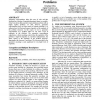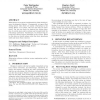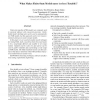2181 search results - page 2 / 437 » When Can We Test Less |
MOBISYS
2007
ACM
14 years 5 months ago
2007
ACM
Except for a handful of "mobile" Web sites, the Web is designed for browsing with personal computers with large screens capable of fitting the content of most Web pages....
CVPR
2010
IEEE
14 years 12 days ago
2010
IEEE
We present a method for real-time 3D object detection
that does not require a time consuming training stage, and
can handle untextured objects. At its core, is a novel tem-
plat...
GECCO
2008
Springer
13 years 7 months ago
2008
Springer
Generative representations allow the reuse of code and thus facilitate the evolution of repeated phenotypic themes or modules. It has been shown that generative representations pe...
MSR
2006
ACM
14 years 4 days ago
2006
ACM
Refactorings are program transformations which should preserve the program behavior. Consequently, we expect that during phases when there are mostly refactorings in the change hi...
KBSE
2002
IEEE
13 years 11 months ago
2002
IEEE
Finite-state machine (FSM) models are commonly used to represent software with concurrent processes. Established model checking tools can be used to automatically test FSM models,...



